The Tei Tei Project by Louise Rosenfield
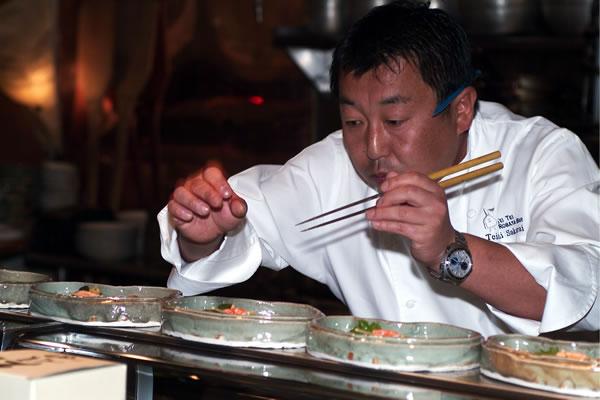
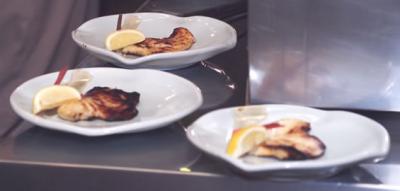 This article was originally published in the Feb 2006 issue of Ceramics Monthly, vol.54 #2, pages 43-47. Download the PDF.
This article was originally published in the Feb 2006 issue of Ceramics Monthly, vol.54 #2, pages 43-47. Download the PDF.
While living with a host family in 1997, as a participant in the International Workshop of Ceramic Art in Tokoname (IWCAT), Peter Beasecker remembers “seeing close up, the life of a Japanese pot, which was quite different from all my experiences in museums, galleries, restaurants, and even with friends’ collections. Types of pots, which before I had seen in a more rarified way became a part of an everyday experience, and with that, an unfolding of an appreciation and understanding that can only come through use. Upon coming home and returning to the classroom, my nagging dilemma was, ‘How could I bring a semblance of this experience to my students?’ and more broadly, ‘How could I personify the abstract nature of problem solving for the average 20 year old college student making an utilitarian vessel?’” And so the “Tei Tei Project”, as it is commonly referred to within the Meadows School of the Arts at Southern Methodist University, where Peter teaches, was born.
Tei Tei, is one of two small restaurants in Dallas, Texas, owned and operated by Chef Teiichi Sakurai, a native of Tokyo. Peter chose to approach this restaurant not only because of the reputation of Chef Sakurai, but because he knew that the Chef was sympathetic to hand-made pots. “As soon as I walked into the restaurant I was greeted by a large Sam Clarkson platter hanging on the wall, and one of his soy bottles was on every table,” he recalls. Chef Sakurai remembers, “When Peter came in and talked with me about his idea, I thought about my own vision of operating a restaurant, which is to introduce Japanese culture to this country in the right way. This was a perfect project to introduce the culture to students, because every single pot has a meaning for the food.” Briefly, the project involves three separate meetings with Chef Sakurai and culminates with a feast of up to a dozen courses, depending upon the number of students enrolled in the class.
Top-first: At the Tei Tei Robata Bar, Chef Teiichi Sakurai prepares a sashimi course in Bowls for Spring Season, 7 in. (18 cm) in diameter, thrown, then fired to Cone 10 in reduction, by Amelia Jones.
Top-second: Grill Plates for Spring, 7 in. (18 cm) in diameter, hold grilled seabass with pickled ginger and lemon, thrown and altered porcelain, with celadon glaze and fired to Cone 10 in reduction, by Elisa Difeo.
Below: The second meeting of Chef Sakurai and the students takes place at the Meadows School of the Arts studio in Dallas, Texas, where he critiques the greenware pieces, like Amy Miller’s Dessert Bowl for Spring.
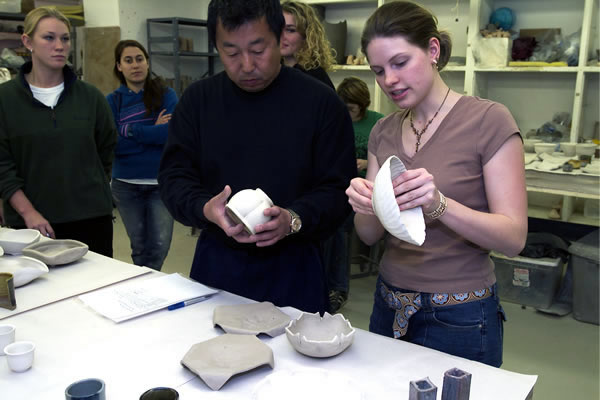
The suitability of Japanese cooking to this kind of project comes from a long, solid cultural background, the essence of which is its observance of nature. A survey of Japanese art - painting, poetry, literature, music, and even cooking, highlights the Japanese society’s acute awareness of the seasons. According to ShizuoTsuji, noted chef and cookbook author, Japanese culture was born of austerity. Even the imperial court in Kyoto was impoverished. But the cultivated nobles learned to delight in the offerings of each changing season, making the most of what nature provided, when each fish, fowl, fruit or vegetable was at its prime. In the 6th century, Buddhism took hold in Japanese society, and meat was made taboo. The contradiction here was that Buddhism had originated in countries with tropical climates, with bountiful harvests of fruits and vegetables. The mostly temperate Japanese island climate provided a severely limited selection of edible choices. Therefore, making the most of nature’s seasonal offerings with the utmost culinary artistry gave rise to the traditional Japanese meal: Many small courses, each a work of art in which much time and thought is spent, with the utensils constituting an important part of the sensual experience, all with emphasis toward satisfying the needs and desires of the guest. A traditional Japanese banquet consists of a great many small portions - the greater the variety, the more extravagant the hospitality.
THE FIRST MEETING
Students initially meet with Chef Sakurai at Tei Tei on a Monday, the day the restaurant is closed. There, they get a sense of the ambiance of the space, explore Chef Sakurai’s large inventory of pots (organized by season), and listen as he shares his thoughts on everything from the landscape of his homeland to the salute he gives his patrons as they leave the restaurant. Chef Sakurai says, “I want to give the students an understanding of where I come from, my thinking. I tell them to try to understand about how I think about the seasons by looking at nature, sensing the seasons, and going to the Mall to see what designers are showing in terms of color and texture.” Toward the end of the meeting, Chef Sakurai assigns courses to each individual student and, one person/course at a time, explains the intricacies and requirements of a specific vessel for the assigned course. For example, in the requirements of a “rice bowl for the spring season,” he explains how a rice bowl will be held, the needs of the foot, and general height to allow the bowl to be held in one hand. For other courses, such as “fry”, the plate will be covered with a neatly folded piece of paper. In that case, creativity and an idea that expresses the season is more important, and specific formal requirements are not as necessary as for “rice”. However, even with courses which have vessels with stricter formal issues, creativity and an idea for the season is paramount. The students are always advised to, “Use your imagination and look at nature.” Peter remarks that at this meeting, “Students typically take this far more seriously than the usual classroom assignment, partly because it’s not on familiar ground and partly because they’re not responsible to me. It changes the context of the discussion and because of Chef Sakurai’s presence, it adds an element of uniqueness and seriousness. One thing I impress upon the students is that this project is an exchange of gifts, culture, and talents. No money is involved, which would introduce commerce and bring a different energy into the mix. ”
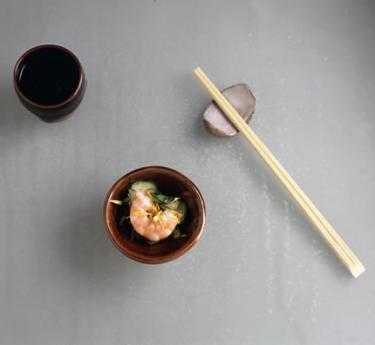
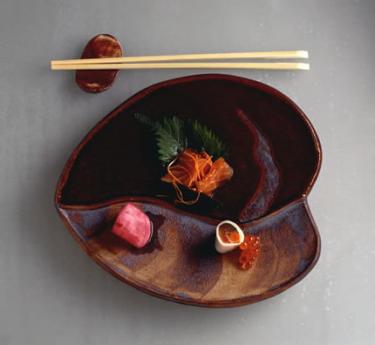
Left: Little Bite Dish for Fall, 3 in. (8 cm) in height, press-molded stoneware, glazed and fired to Cone 10 in reduction, by Stefan Chinov. Little Bite, usually the first course in Japanese cuisine, is seen here with Ebisunimono (shrimp salad) and Japanese cucumber, hashioke (chopstick rest) and a sake cup.
Right: Matsumae (seaweed) zuke (marinated) salmon with turnip pickle and kinuta maki (salmon roe role) is an example of 3 Things, the course following Little Bite. Three Things Plate for Fall, 7 in. (18 cm) in length, thrown and cut stoneware, glazed and fired to Cone 10 in reduction, by Victoria Hicks.
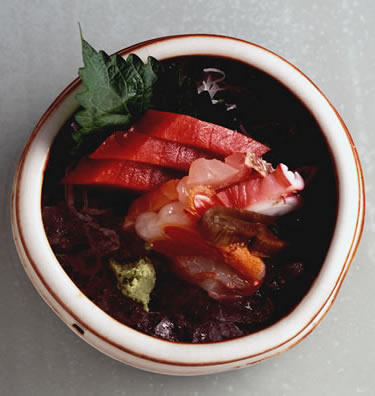
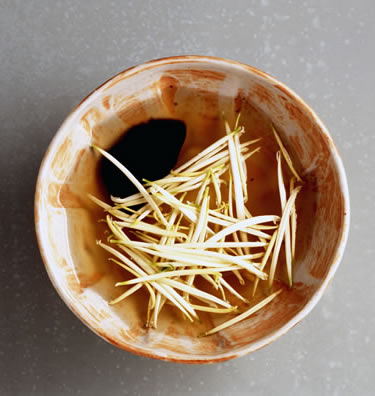
Left: Sashimi Bowl for Fall, filled with Blue fin tuna, sweet shrimp, octopus and uri (squash) pickle, 6 in. (15 cm) in diameter, thrown stoneware, with Shino glaze, fired to Cone 10 in reduction, by Debbie Reichard.
Right: Mum suimono (chrysanthemum soup) with shitake mushroom in Soup Bowl for Fall, 4 in. (10 cm) in diameter, thrown and altered stoneware, with slip and Shino glaze, fired to Cone 10 in reduction, by Larkin Evans.
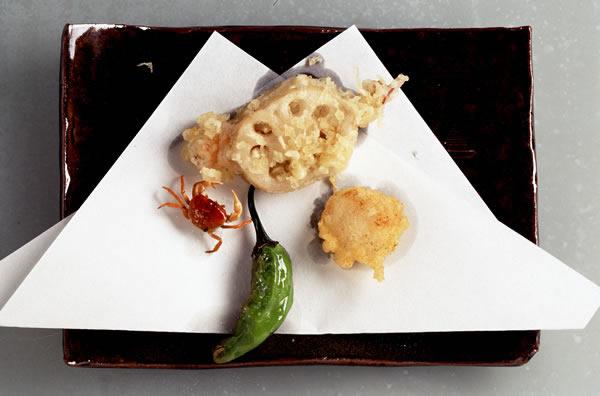
Above: Fry Plate for Fall, 8 in. (20 cm) in length, handbuilt stoneware, glazed and fired to Cone 10 in reduction. The fry course usually consists of tempura, like Kabochi (pumpkin), lotus root and ebishinjo (shrimp), shown here with a shishito (chile pepper) and baby sawagami (river crab).
Mum suimono (chrysanthemum soup) with shitake mushroom in Soup Bowl for Fall, 4 in. (10 cm) in diameter, thrown and altered stoneware, with slip and Shino glaze, fired to Cone 10 in reduction, by Larkin Evans.
THE SECOND MEEETING
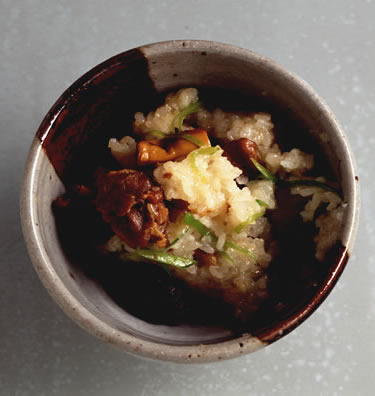
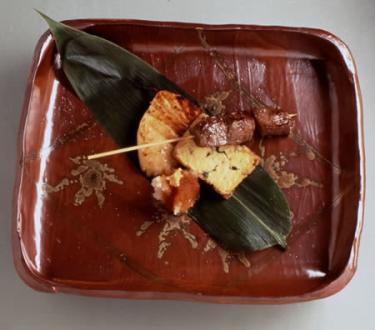
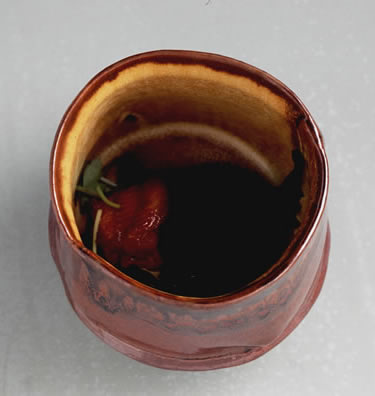 Now the problem solving begins. Students return to the studio and create 5 to 7 prototypes. After a couple of weeks, Chef Sakurai comes to the studio to view and critique their efforts. The presentation is extremely formal, work tables are covered with white paper and each person’s work is presented separately. Chef Sakurai is thoughtful in his discussion, addressing the advantages and disadvantages of each prototype before settling on a piece. Sometimes, none of a person’s work is acceptable, and they have to go back to the drawing board. But they always have a better understanding of where they missed the mark. Chef Sakurai also has in mind the look of the entire ensemble together and how they will work following one another during the meal. At the end of this critique, one table has all the selected pieces on it, and the students begin to understand the underlying idea and aesthetic at work.
Now the problem solving begins. Students return to the studio and create 5 to 7 prototypes. After a couple of weeks, Chef Sakurai comes to the studio to view and critique their efforts. The presentation is extremely formal, work tables are covered with white paper and each person’s work is presented separately. Chef Sakurai is thoughtful in his discussion, addressing the advantages and disadvantages of each prototype before settling on a piece. Sometimes, none of a person’s work is acceptable, and they have to go back to the drawing board. But they always have a better understanding of where they missed the mark. Chef Sakurai also has in mind the look of the entire ensemble together and how they will work following one another during the meal. At the end of this critique, one table has all the selected pieces on it, and the students begin to understand the underlying idea and aesthetic at work.
Following the initial critique, each person produces enough of their assigned vessel for 5 or so glaze tests and the number of final dishes which again is determined by the number of students. This is probably the most difficult and challenging part of the project, because the sizes, volumes, and shapes must be extremely uniform. Chef Sakurai prefers no more than an eighth to quarter inch variance and points out that if two people receive the same amount of rice, but one bowl is 2″ larger, one person will feel shorted, “…and this doesn’t go over well in the restaurant business.” The glaze tests require creative thinking about the season for which the dishes have been designed and the texture of the landscape that Chef Sakurai has described. Fall colors and motifs of dying leaves, dark days, slowing down of life, are different from Spring colors and motifs of new life blossoming, ice and snow melting, new grass shooting up from recently warmed ground. Here, each student’s idea is very important. So even those who have been given courses with more rigid formal requirements must now consider how the food will look in the vessel, and how the vessel can represent the season.
THE THIRD MEETING
At the next critique, Chef Sakurai comes to the studio to view the five prototypes that have been glazed. The work is discussed and the final glaze combinations are decided upon. At the end of this visit, the students can see the final selections together, and get a feeling of the visual pace of the meal. The remaining inventory is glazed and fired and delivered to Chef Sakurai so that he can have a week or two to respond to the work and reconsider his relationship to the pieces and make the appropriate changes to the menu. “I will always try to see what the best fit is between my idea and the student’s work. Sculpture speaks for itself, but as a chef, I believe that pottery provides a foundation for collaboration. I suggest to students that we have to have mutual respect. The food shouldn’t overpower the pot, and the pot shouldn’t overpower the food. Just like when you are shopping for clothes, and you visualize yourself in a certain jacket you see. You want the combination to be just perfect.”
Above: Rice Bowl for Fall, 4 in. (10 cm) in diameter, thrown, with slip and glaze, fired to Cone 10 in reduction, and full of Mastaki mushroom okowa (steamed rice).
Grill Plate for Fall, 11 in. (28 cm) in length, handbuilt porcelain, with Shino and ash glazes, fired to Cone 10 in reduction, by Louise Rosenfield. Kobe beef skewer, atsuage (tofu), daikon (white radish) and Suzuki (sea bass) on haran (type of bamboo) leaf.
Braise Bowl for Fall, 5 in. (13 cm) in diameter, handbuilt stoneware, fired to Cone 10 in reduction, by Jerilyn Virden, seen here with Hachiman (Shinto god) maki (roll).
THE BANQUET
The dinner is on a Monday evening and is always a private affair due to the restaurant being closed that day. The students arrive at the restaurant, full of anticipation of the fantastic feast, and anxious and nervous about how their dishes will look. Everyone is dressed up, with cameras in hand to document the evening. They are seated at a bar that surrounds the cooking area, and can watch the actual banquet preparation. Chef Sakurai and his two assistants work studiously over their stations, and the sounds of preparations and the smell the cooking fill the small restaurant. The experience starts with a warm cloth, and cold sake is poured. Each course is presented in the special order typical of Japanese cuisine:
- Little bite - a small taste of food with your drink - ebisunomono, Japanese cucumber with hashioke, chopstick rest and sake cup
- Three-Things - a tiny taste that starts showing the season with the food - matsu mae zuke, turnip pickle, kinuta maki (special salmon, turnip pickle and special salmon roe)
- Sashimi - crushed ice in a bowl topped with seasonal raw fish - blue fin tuna, sweet shrimp, octopus, uri squash pickle
- Soup - It’s important to have proper size, shape, and especially, rim, because you are supposed to drink the soup, not use a spoon. - mum suimono with shitake mushroom
- Fry - Tempura - A flat plate with paper folded on top of the plate. The shape of the folded paper should be considered when designing the shape of the plate. - kabochi pumpkin, lotus root, sbishino, shishito pepper, baby sawagani
- Rice - bowl must be right size to hold with one hand, one finger underneath, with thumb on rim. Shape of rim is important for comfort. - mastaki mushroom okowa
- Grill - food cooked over oak charcoal - Teich likes to cook grilled fish skewered to make it bend and look like it’s swimming when served - sea bass with ginger pickle and lemon, or, kobe beef skewer with atsuage tofu, daikon radish, Suzuki sea bass on haran leaf
- Braise - High and tall bowl to keep contents warm. Must be able to accommodate chop sticks at no larger than a 45 degree angle. - hachiman maki
- Steam - Similar size and shape to Braise, but for spring, sometimes smaller. Mountain potato with snapper and shitake mushrooms
- Dessert - Not heavy, should clean the palate - pickle cherry blossom leaf with green tea custard and strawberries, or, sake ice cream with malon chesnut puree
As each course is presented, Chef Sakurai briefly explains what everyone is about to eat. At this point the chefs stop their frenzied preparations to watch the reactions of the students. The feeling each person gets when their dishes are presented with the most beautiful food is hard to explain. The first year when two Japanese students participated in the project, they were so overwhelmed with emotion, they cried. The students soon realize how special their dishes are to Chef Sakurai and the restaurant, as he spared no expense, ordering Cherry Blossom branches from Japan and serving the most expensive Sake on the wine list. This exchange of gifts and talents, is put into perspective when the students realize how much thought, creativity, effort and expense Chef Sakurai lavishes on them. When dressed with beautiful food, the tableware had transcended simple plates and bowls. In the 5 years that Peter has repeated this project, Chef Sakurai has yet to repeat a dish. He believes that layers of flavors add sophistication, and aftertaste of each bite is an important consideration in developing a menu. The vessels provide an additional layer, for a complete sensual experience. At the end of the evening, both Chef and Professor are recognized with applause.
About the Author: Louise Rosenfield has participated in the Tei Tei project since its inception, and has become obsessed with expensive sake. Tei Tei is one of her favorite restaurants because “it’s a joy for me to be served beautiful delicious food on hand-made dishes created by our class.”
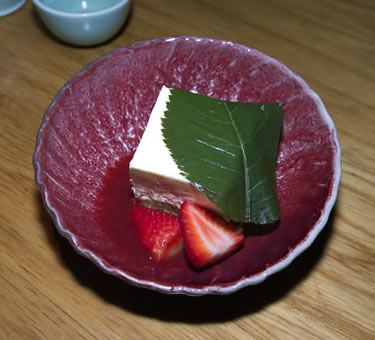
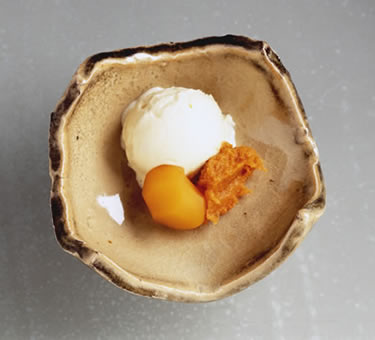
Left: Pickled cherry blossom leaf, strawberries and green tea custard in Dessert Bowl for Spring, 6 in. (15 cm) in diameter, thrown and altered porcelain, with copper red glaze, by Amy Miller.
Right: Sake ice cream with malon (chestnut) and chestnut pure?e complete this Dessert Bowl for Fall, 5 in. (13 cm) in diameter, handbuilt porcelain, with Shino glaze, fired to Cone 10 in reduction, by Lael Sale.